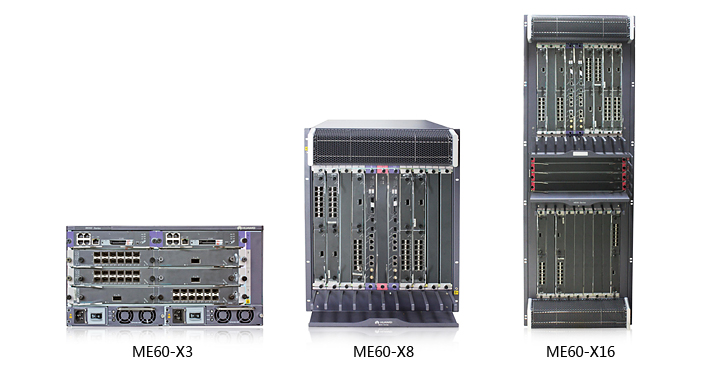| Attribute
|
ME60-X16
|
ME60-X8
|
ME60-X3
|
| Switching Capacity
|
25.2 Tbps /12.58 Tbps
|
12.58 Tbps /7.08Tbps
|
1.08 Tbps
|
| Slots
|
22 slots, including 2 MPUs (1:1 backup), 4 SFUs (3+1 backup), and 16 LPUs
|
11 slots, including 2 SRUs (1:1 backup), 1 SFUs (2+1 backup), and 8 LPUs
|
5 slots, including 2 MPUs (1:1 backup) and 3 LPUs
|
| Dimension
(W×D×H)
|
442mm×650mm×1420mm(32U)
|
442mm×650mm× 620 mm(14U)
|
442mm×650mm×175 mm (DC 4U)
442mm×650mm×220 mm (AC 5U)
|
| Maximum power consumption
|
4610W(120G)
7970W(240G)
|
2340W(120G)
4100W(240G)
|
1070W(AC)
920W(DC)
|
| Weight in full configuration
|
246kg (120G)
279kg (240G)
|
119kg (120G)
136kg (240G)
|
42kg (DC)
52kg (AC)
|
| Interface type
|
OC-192c/STM-64c POS
OC-48c/STM-16c POS
OC-3c/STM-1c POS
OC-12c/STM-4c ATM
OC-3c/STM-1c ATM
100GE-WAN/LAN
10GE-WAN/LAN
GE/FE
E3/CT3
CE1/CT1
|
| BRAS
|
User access protocol:PPPoE, PPPoEoA, IPoE, IPoEoA, PPPoA 802.1X, and ND
User authentication protocol:PAP, CHAP, MSCHAP, RADIUS and HWTACACS
User accounting protocol:RADIUS, HWTACACS and COPS
User authorization protocol:RADIUS, HWTACACS and COPS
Policy protocol:COPS, COA
|
| L2TP
|
Session number: up to 64K/per slot, up to 128K/per chassis
Tunnel number: up to 16K/per slot, up to 16K/per chassis
|
| IPv4
|
Static routing protocol and dynamic routing protocols such as RIP, OSPF, IS-IS, and BGP-4.
|
| IPv6
|
Various technologies for transition from IPv4 to IPv6:
Manual tunnel configurations, automatic tunnel configurations, IPv6-to-IPv4 (6-to-4) tunneling, Generic Routing Encapsulation (GRE) tunneling, and Intra-Site Automatic Tunnel Addressing Protocol (ISATAP) tunneling.
IPv4 over IPv6 tunneling and IPv6 Provider Edge Router (6PE).
IPv6 static routing protocol.
IPv6 dynamic routing protocols such as RIP Next Generation (RIPng), OSPFv3, IS-ISv6, and BGP4+.
IPv6 neighbor discovery and path Maximum Transmission Unit (PMTU) discovery.
Transmission Control Protocol Version 6 (TCP6), ping IPv6, traceroute IPv6, socket IPv6, static IPv6 Domain Name System (DNS), specifying the IPv6 DNS server, Trivial File Transfer Protocol (TFTP) IPv6 client, and IPv6 policy-based routing.
Internet Control Message Protocol Version 6 (ICMPv6) Management Information Base (MIB), User Datagram Protocol Version 6 (UDP6) MIB, TCP6 MIB, and IPv6 MIB.
|
| MPLS
|
LDP over TE, VPLS, H-VPLS, policy-based routing in VPN.
MPLS L2VPNs in either Martini or Kompella mode.
VLL/VPLS access L3VPNs.
QinQ, MPLS/BGP L3VPN, and inter-AS VPN Option A/B/C.
Asynchronous Transfer Mode (ATM) E1, Inverse Multiplexing over ATM (IMA), and Time-Division Multiplexing (TDM) PWE3.
MPLS-TP
|
| Layer2 Feature
|
IEEE802.1q, IEEE802.1p, IEEE 802.3ad, and IEEE 802.1ab.
Spanning Tree Protocol (STP), Rapid Spanning Tree Protocol (RSTP), Multiple Spanning Tree Protocol (MSTP), RRPP, DHCP+, VLAN switching, and user binding.
|
| Reliability
|
BGP GR, IS-IS GR, and OSPF GR.
LDP GR, Resource-Reservation Protocol (RSVP) GR, and Non-Stop Forwarding (NSF).
VLL/VPLS/L3VPN GR/NSF.
Multicast NSF.
BGP/IS-IS/OSPF/LDP/RSVP-TE/PIM/ISSU Non-Stop Routing (NSR).
In-Service Software Upgrade (ISSU).
Fast convergence of Interior Gateway Protocols (IGPs), BGP, and multicast routing
IP/LDP/VPN/TE/VLL FRR.
IP Auto FRR.
BFD for the static routing protocol and protocols such as IS-IS, RSVP, LDP, TE, Label Switched Path (LSP), PW, OSPF, BGP, VRRP, PIM, and RRPP.
RRPP.
MPLS OAM and Ethernet OAM, Y.1731.
Backup of service routers, PW redundancy, and PWE3 end-to-end protection.
E-Trunk, E-APS, E-STP.
1+1 or 1:1 intra/ inter -chassis warm or hot backup of CGN service
|
| QoS
|
Weighted Random Early Detection (WRED), DS-TE capability with a maximum of eight CTs, five-level H-QoS scheduling, VLL/PWE3 QoS, and MPLS H-QoS.
The last mile QoS.
Multicast replication of IPoE access users
|
| DAA
|
ME60 supports DAA(Destination Address Accounting)feature, providing refined subscriber management with differentiated service and accounting in IP networks.
|
| Multicast
|
IGMPv1, IGMPv2, IGMPv3, IGMP snooping, multicast VPN, and IPv6 multicast.
Static multicast routes.
Multicast routing protocols: PIM-DM, PIM-SM, PIM-SSM, Multicast source Discovery Protocol (MSDP), and Multiprotocol BGP (MBGP).
Support deployment of both multicast and TE.
Multicast CAC
|
| Security
|
ACL filtering, URPF, GTSM, DHCP Snooping,
Anti-ARP attack、anti-DOS attack
MAC address limitation, bonding between MAC and IP
SSH, SSH v2
|
| CGN
|
NAT444, NAT64
Distributed deployment or integrated deployment
Re-allocation or dynamic allocation of ports
VPN NAT
NAT ALG (FTP/ICMP/PPTP/RTSP/SIP)
Port forwarding
NAT server
Web user’s authentication
DS-Lite
L2-Aware NAT
|

